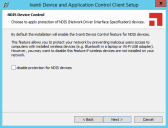Upgrading the Client
Using the Ivanti Device and Application Control installation software, the Installation Wizard upgrades the Ivanti Device and Application Control client, the fourth Ivanti Device and Application Control component that you upgrade.
Caution: When installing the client for Application Control, you may need to set the Execution blocking default option to Non-blocking mode. This is only necessary if the new client .exe and .msi files were not previously added to the central file authorization list and assigned to the corresponding file group. Otherwise, the Ivanti Device and Application Control client computer may not restart after Ivanti Device and Application Control client installation because executable system files cannot run until they are centrally authorized from the Management Console.
- Log in to the computer that will run the Ivanti Device and Application Control client.
- Close all programs running on the computer.
- From the location where you saved the Ivanti Device and Application Control application software, run the \client\Client.exe file.
The Installation Wizard Welcome page opens. - Click Next.
The Encrypted communication page opens.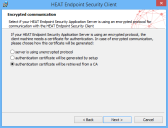
- Select one of the following options that matches the options you selected when you upgraded the Application Server.
- To manually generate a certificate during setup, specify the computer certificate location and parameters from the following options.
- Click Next.
The Application Servers page opens.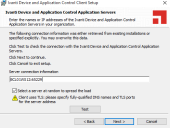
- Specify up to three server names using fully qualified domain names (FQDN) or IP addresses that are managed from the Management Console.
- Verify that the Ivanti Device and Application Control client connects to the Application Server by clicking Test.
If the server name is correctly specified, the Application Server connects successfully with the client. - Click Next.
The “Add or Remove Programs” list page opens.
- You may select one of the following options, which are not required to proceed with the upgrade:
- Click Next.
- Select the disable protection for NDIS devices check box to allow the use of wireless devices.
- Click Next.
The Ready to Upgrade the Program page opens.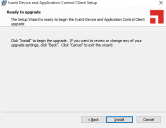
- Click Upgrade.
A progress bar runs on the page, showing installation progress, then the Completed page opens. - Click Finish.
Ivanti Device and Application Control setup upgrades the existing Ivanti Device and Application Control client.
|
Option |
Description |
|---|---|
|
Server is using unencrypted protocol |
Communication between the Application Server and Ivanti Device and Application Control client is not using the TLS communication protocol. Communication is not encrypted but is signed using the private key. |
|
Authentication certificate will be retrieved from a CA |
Communication between the Application Server and Ivanti Device and Application Control client uses the TLS communication protocol. Communication is encrypted and the digital certificate is retrieved automatically during installation. |
Tip: Ivanti recommends that you use the automatic TLS retrieval option to deploy Certificate Authority infrastructure for issuing valid digital certificates.
If you opt to manually generate a certificate during setup, the Client Authentication dialog opens.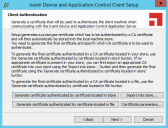
|
Option |
Description |
|---|---|
|
Generate certificate signed by certificate located in store |
Generates a digital certificate during installation by using a signature certificate located in the local user store. |
|
Generate certificate signed by certificate located in file |
Generates a digital certificate during installation by using a signature certificate located in a specified file. |
|
Import into store |
Imports a signature certificate into the local user store. |
|
Certificate parameters |
Specifies the certificate parameters for the Cryptographic service provider, Key length, Validity, and Signature. |
Caution: Do not use IP address(es) when using the TLS communication protocol for encryption. You can only use FQDNs for when using the TLS communication protocol.
|
Option |
Description |
|---|---|
|
Don’t display this product |
Displays the Ivanti Device and Application Control product name in the Add or Removes Programs list in the Windows Control Panel with the Remove option. |
|
Don’t display the Remove button for this product |
Displays the Ivanti Device and Application Control product name in the Add or Removes Programs list in the Windows Control Panel without the Remove option. |
Attention: If NDIS was configured for the previously installed client version, the upgrade process may skip this step and proceed directly to the following step.
The NDIS Device Control page opens.
NDIS enables Device Control to control 802.1x wireless adapters. If you do not need this protection, you may disable it here.
After Completing This Task:
You must restart your computer system as soon as possible, to prevent any existing file authorizations or device permission from becoming unstable and for the Ivanti Device and Application Control client configuration changes to become effective.
